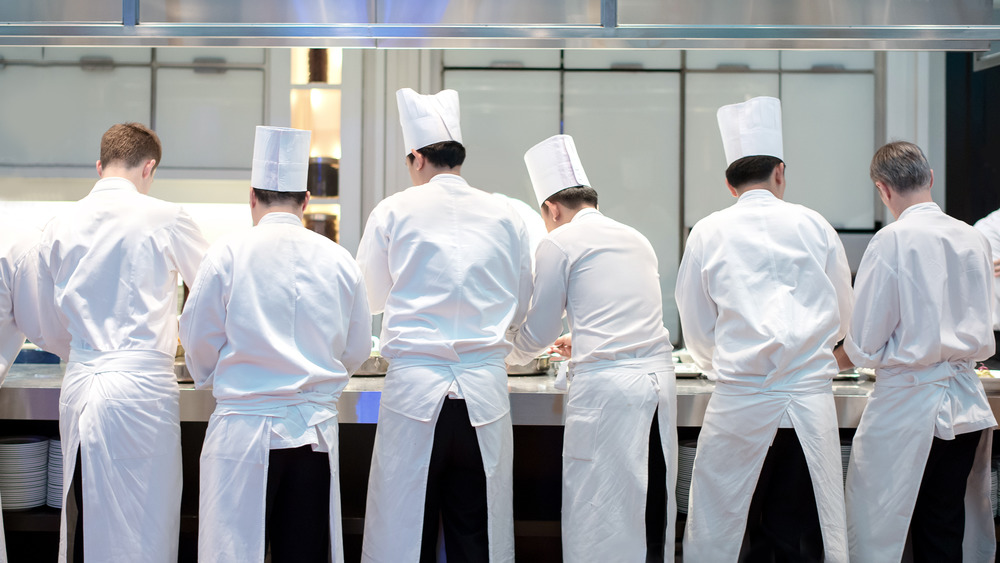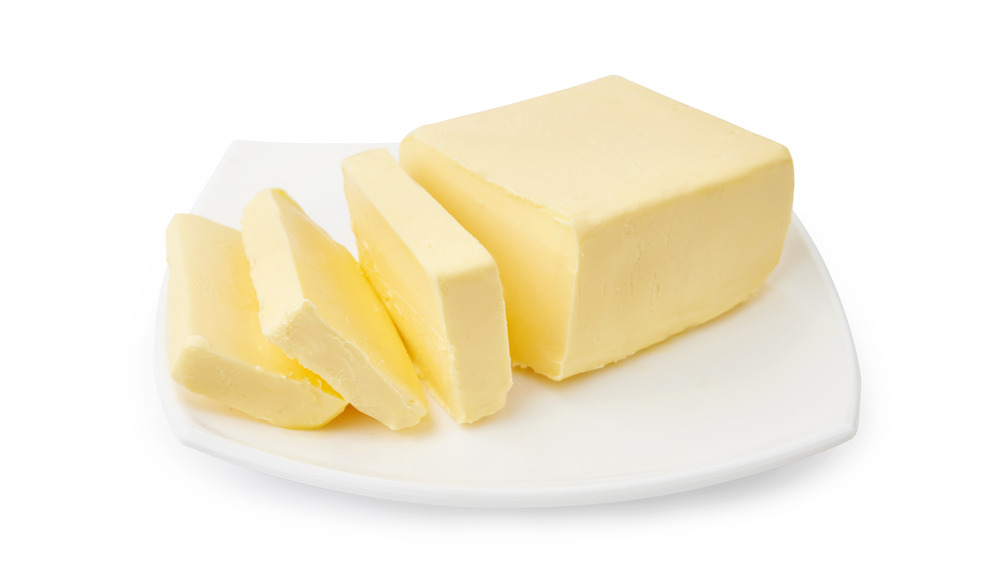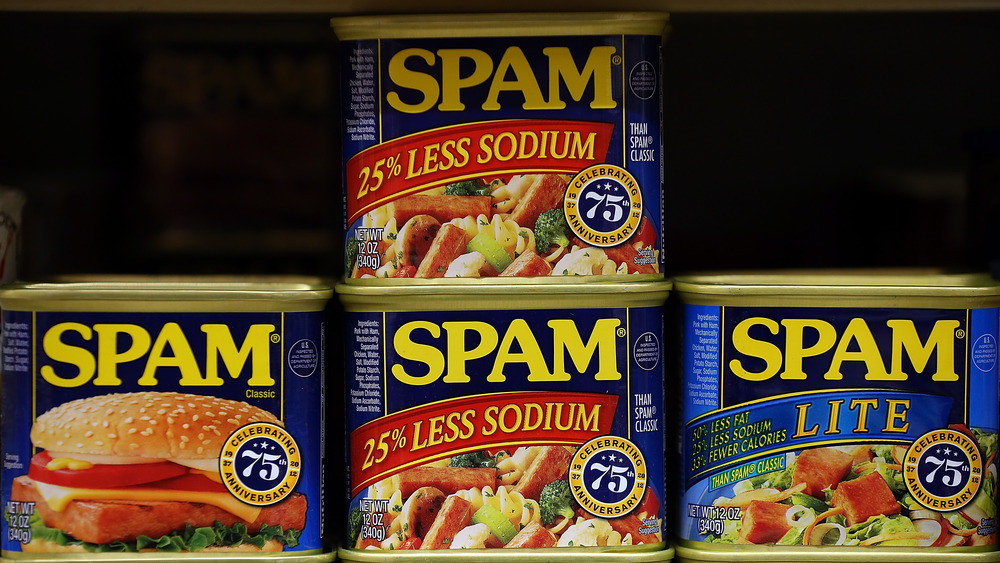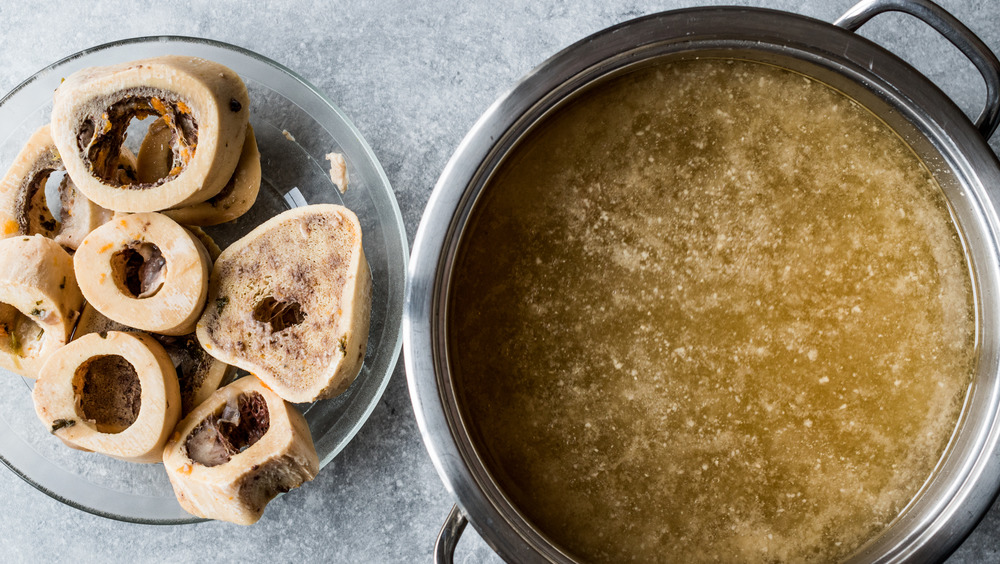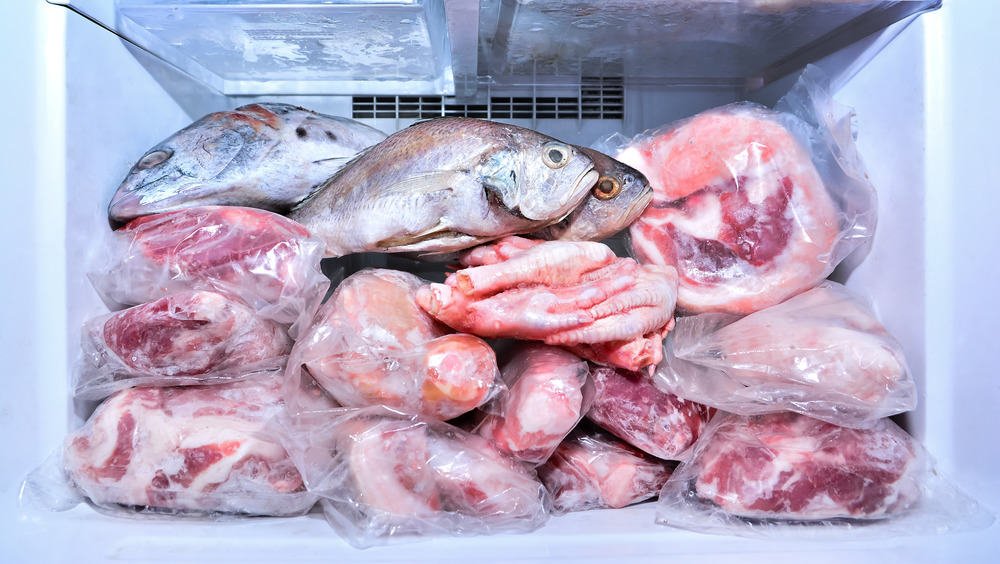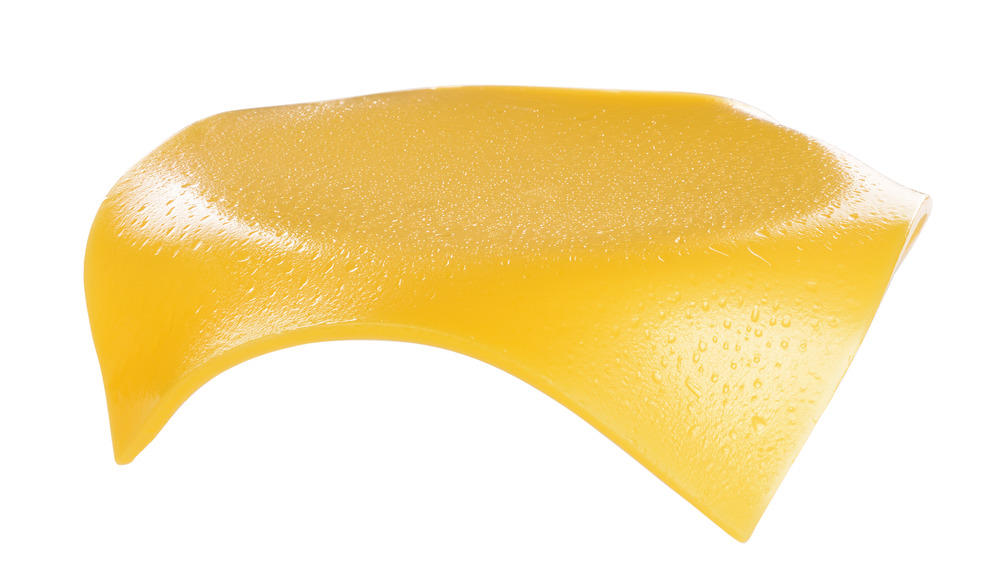Ingredients You'd Be Surprised High End Restaurants Actually Use
One night you go to make dinner, but when you open your pantry, you're disappointed to only find things in cans, jars, and boxes. You don't feel like eating cheap, pre-made foods tonight. You decide to splurge and take yourself out to a high-end restaurant where you trust you'll be served only high-quality foods that have been made by hand, by expert chefs.
Sounds good, right? But what you may not realize is that the fancy restaurant and its hefty bill at the end of the night may not be making everything from scratch. In fact, their professional pantry may look surprisingly similar to yours, only much, much bigger. Meanwhile, you might not realize that some ingredients are even edible though, in some cases, you'd really miss out if you didn't give a few of these surprising ingredients a try.
If you could peek into the kitchen of a fancy restaurant, you might find loads of surprises in the pantry, some of them innocuous, others absolutely delicious, and a few items a bit more of an unwelcome shock. Here are some of the unexpected ingredients you don't expect to get involved when you dine out at a restaurant.
Freezer to table veggies
Despite the popularity of the "farm to table" concept, many restaurants are still using frozen vegetables for a variety of reasons. Fresh vegetables expire more quickly, for one. The time-sensitive nature of vegetables makes them more expensive to ship, which means restaurants have to charge more and hand you a heftier bill. In an industry with frighteningly small profit margins, this is not exactly a good way to attract more customers. But frozen vegetables aren't only used to save restaurants money. Believe it or not, it's also about flavor.
According to Healthline, fresh vegetables are usually picked before they are ripe, which helps distributors earn a few precious extra days before their product goes bad. Frozen vegetables, on the other hand, are picked at their ripest before being immediately processed. This means that frozen fruits or vegetables may, surprisingly enough, have more flavor than their fresh counterparts. Harvard Medical School reports that frozen vegetables also lose fewer nutrients than fresh ones during shipping.
So as counter-intuitive as it may seem to a diner, you don't necessarily have to freak out if the veggies on your plate were once frozen. If a restaurant can't get local produce, frozen veggies might be a perfectly healthy, flavorful option.
Some restaurant desserts come from a box
Perusing your favorite restaurant's dessert menu, you may have certain ideas. Sure, you don't necessarily expect that the kitchen is churning their own ice cream, but you may think they're at least making the cakes from scratch. Well, not so fast. As it turns out, many restaurants and even bakeries are using the same secret ingredient: boxed cake mix. According to commenters answering a question on the Times Union's "Table Hopping" blog, some restaurants and bakeries really do use this shortcut. However, some professionals like Cake Boss, argue that mixes are only pre-measured ingredients and shouldn't be so stigmatized.
Whether or not that bothers you depends on your own taste experience and the final tally of your meal's bill. If a restaurant is just following the directions on the back of the box and topping the result with some canned frosting, then you might as well do that yourself. But if they're using high-end ingredients, custom additions, and homemade frosting, that can make all the difference. As much as a cheat as it may seem, if the result is a better tasting cake, then why shouldn't restaurants and bakeries build up from a boxed mix base?
Restaurant fishes might come from a can
There's definitely a prejudice out there against canned foods, with some people turning their noses up at the often high sodium contents and occasional weird tastes contained in a can. Despite this, the canned food market is expected to grow by billions of dollars over the next few years (via Business Wire).
Still, with everything from fruit cocktails to beans to seafood, if it comes in a can, it's often seen as cheap and therefore inferior. But cheap doesn't automatically mean low-end. According to The Daily Meal, some well-known restaurants from New Orleans to Tokyo unabashedly have canned seafood on the menu. Some even serve it straight out of the can!
When eating at a fancy restaurant near the coast, you might expect all the seafood to be fresh-caught. But while they might be just a stone's throw away from a supply of fresh seafood, preparation time still comes into play, complicating things for chefs. As many Americans prefer their fish skinned, deboned, and filleted, too, that extra prep time comes into consideration pretty quickly. Pre-processed options are a time-saver when you're a harried chef facing hungry diners. To that end, some places are rather open about their use of canned fish. Condé Nast Traveler reports quite a few restaurants worldwide have canned fish proudly available for diners.
An entire stick of butter
That restaurants use butter likely surprises no one. However, the kicker in some fancy restaurants' cases is just how much butter is used. In The New Yorker, chef Anthony Bourdain wrote that butter is "the first and last thing in almost every pan [...] In a good restaurant, what this all adds up to is that you could be putting away almost a stick of butter." If you were to, for some ungodly reason, eat a whole stick of, let's say, some unsalted Land O'Lakes butter, that would be 88 grams of fat and 800 calories. And remember that all of that is just the butter. Whatever meal is cooked and coated in that butter is, naturally enough, going to increase the number of calories that you're consuming. However, keep in mind that Bourdain was ultimately arguing in favor of butter and its flavor.
While a high-end restaurant could pay extra for more expensive meats, adding more butter is a significantly cheaper option. Butter will also often be used to keep a chicken or steak tender and moist. It's also what gives the meat that appetizing sheen, ultimately meaning that your fancy meal could be coated in way more butter than you might have initially expected when sitting down at your table.
Classic canned meat is on some plates
If there is one food that many Americans would consider the opposite of fine dining, it's got to be Spam. It's looked down upon as some sort of mystery meat, but it's actually just six common ingredients: mixed pork and ham, water, potato starch, sugar, salt, and sodium nitrite. While it's nothing fancy, it's also nothing too strange. Its cheap price point and long shelf-life make it seem as far from fancy as possible. At least, that's how it is often perceived in the United States.
Meanwhile, in South Korea, Spam is considered a high-quality ingredient and even an appreciated holiday gift, according to the BBC. It seems that luxury is all in the eye — or maybe taste buds — of the beholder. For their part, daring chefs in America have taken up the cause of canned meats, adding them to their menus and winning over converts one bite at a time. From Los Angeles. to New York City, Spam is increasingly on some desirable and expensive menus, reports Foodbeast. Perhaps it's time to give it a try next time you see it on a menu, much as it may not seem to fit in with champagne and caviar.
Mayonnaise might be snuck into a meal instead of aioli
While both mayonnaise and aioli have their place in cooking, one of them sounds distinctly fancier than the other, doesn't it? According to The Spruce Eats, the rather more high-class-sounding aioli is a garlic-based sauce, while mayo is egg-based. Both are mixed with oil and result in a thick and creamy condiment. While the two concoctions may seem similar and, indeed, "aioli" is sometimes used when talking about mayonnaise, professionals know the difference. Mayo is found in most refrigerators across the United States, while real aioli made from just olive oil and garlic is commonly only found in restaurants or the homes of professional chefs.
Now, many upscale restaurants may claim to have aioli, but it isn't always the real deal. Some places simply spice up a jar of mayo and call it "aioli" to make it sound like it's of higher quality than it really is. You might not be willing to pay as much if you knew the "aioli" on the menu was in reality the same brand of mayo you have in the back of your fridge at home with a few spices thrown in.
Animal bones in the broth
There are parts of an animal we eat in America and parts we don't usually think about eating. Animal bones are typically what we leave on our plates after enjoying a delicious bone-in steak or chicken drumstick. It wouldn't occur to many diners that their favorite fancy restaurant specifically buys just the bones of animals in order to throw them into a cooking pot. That because any restaurant that is taking the time to make soup from scratch is likely going to do it by cooking up some bones.
Of course, depending on your familiarity with bone broth, this may not be quite so shocking. Broth made from bones is full of vitamins, collagen, and amino acids that can be pretty great for your body, according to Healthline. It also has a rich flavor, which is why many high-end establishments keep animal bones on hand to make homemade broth. Meanwhile, as The Denver Post reports, bone marrow can be a decadent savory treat you'd hate to miss on your next restaurant visit.
As unexpected as it might be to walk into a restaurant kitchen and see packages of bones, it is actually a sign of a quality restaurant. The alternative is a frozen broth of potentially unknown age, made of unknown ingredients, sold and shipped from a factory. So, if you happen to notice a few animal bones in the kitchen, take that as a good sign.
Some restaurants might keep animal blood on hand
Blood is another part of the animal that many Americans have never considered edible. In actuality, not only is animal blood potentially good eats, but Fodors Travel says that blood is used as a regular ingredient for cooking in countries across Europe and Asia. Now, blood is finding its way to American high-end dining. But while popular among chefs, food cooked with animal blood isn't often the most popular dish on the menu among patrons, who might be new to the experience and therefore a bit wary. Plainly put, the perceived ick factor keeps many people from giving these recipes a try.
Chefs at fancy restaurants enjoy the challenge of cooking with blood, as Bon Appétit reports, using their skill to make the recipes taste appealing to the discerning diner. It also allows them to explore flavors not offered at every other restaurant. So, why not be just a little brave and try it yourself? While common dishes like prime rib are on the menu at most high-end dining establishments, a dish featuring animal blood as part of the mix definitely stands out, and not necessarily in a bad way.
Frozen meat could be lurking in a restaurant kitchen
As much as you expect a chef to be in the kitchen grilling or pan-frying you a fresh cut of meat, it could be that the meat is instead coming out of the freezer and — yikes — going into the microwave. To be fair, meat can take a long time to cook properly. This means that any pre-preparation, like breading the meat, makes the process take even longer.
This leaves many kitchens looking for shortcuts. Unfortunately, that shortcut is often freezing pre-made meat entrees. Dishes like chicken parmesan are notorious for being premade and frozen, so much so that many chefs in the know never order chicken parmesan, even at a high-end restaurant (via Salon).
This isn't only an American problem, either. France, known worldwide for its gourmet cuisine, has been struggling to keep restaurants and bakeries from becoming mere vending machines of reheated factory food, as The Washington Post reports. While it's cheaper, faster, and easier for restaurants to order premade meals that can be heated up by a minimum wage, entry-level employee, that's definitely not what diners are expecting outside of fast-food chains. And if that's all customers are going to get, there's no reason to go to an expensive restaurant when the same thing can be ordered from a discount menu.
Flowers can be more than a centerpiece
Much like parts of the animal many Americans don't think of eating, there are also plants people don't consider to be prime for their dinner plates. While we don't recommend plucking a flower or two off the centerpiece — the waiters would probably object, for one — you may be surprised to learn that flowers like roses are also fit to be served.
Yes, roses. If you saw a bag of rose petals in the kitchen of an upscale restaurant, you might assume they were there as decoration, but think twice. According to Spiceography, rose petals have been used in foods and medicines for thousands of years. Some restaurants are finally catching up to the trend and adding rose petals to their dishes, too.
Rose petals can be used in sweet or savory dishes, steeped to make tea, cooked into jam, or used to make flavored butter. In American restaurants and bakeries, rose petals are appearing in delicious desserts like Birdie G's rose petal pie in Santa Monica, California (via The New York Times). With their deep colors and romantic connotations, rose petals are a lovely addition to a meal that may surprise some diners, but will surely win them over with the help of a skilled chef.
American cheese, fresh out of its plastic sleeve
Highly processed and with an artificial taste, texture, and appearance, American cheese is popular among children and adults with a craving for nostalgia. It might surprise you to learn that it is also popular amongst some award-winning chefs, too. Despite their ability to sample a wider variety of cheeses than the average person, some chefs are still convinced that American cheese is the best choice, at least for certain dishes. That means the same restaurants that are serving caviar and champagne may also have slices of this cheese product, complete with their tell-tale plastic sleeves (though hopefully someone's remembered to remove that plastic before it hits your plate).
At New York chophouse The Grill, you can enjoy one of the most expensive cheeseburgers in America topped with this very product (via The Daily Meal). This cheeseburger features ground rib-eye, a pricey, high-quality cut of meat, topped with American cheese, which is neither pricey nor high-quality. Don't think that The Grill is anywhere near the only upscale restaurant to use American cheese, either. As Food & Wine reports, many high-end chefs agree that American cheese's melting ability and powerful nostalgia factor make it the only choice for burgers, no matter how extravagant the rest of the ingredients may be.
Whipped toppings may overtake proper whipped cream
No one picks what restaurant to eat at based on the whipped cream served on the dessert, right? But when you're eating a high-priced, specialty slice of cake covered in gold leaf, the familiar taste of processed whipped topping can stand out like a sore thumb. Diners often recognize the taste of the store-bought topping they know from plastic tubs. They also surely know that it often sells for a bargain, which then takes them out of the fine-dining experience they were looking for. And yet, kitchens everywhere from fast-food chains to five-star establishments often have factory-made whipped topping somewhere in their kitchens (via Start Your Restaurant Business).
What's the big deal? First, it's called "whipped topping" and not "whipped cream" for a reason, as The Spruce Eats notes. Whipped topping has the price advantage of not using cream, which even untrained palates may notice is missing. Heavy cream is expensive, but makes better desserts and can improve savory dishes like soups, too (via Eat This, Not That!). So the presence of heavy cream is a good clue that a restaurant is making more items from scratch, other than just whipped cream. Unfortunately, many high-end restaurants are tempted by the cheap, time-saving option, even for a dessert covered in literal gold.
